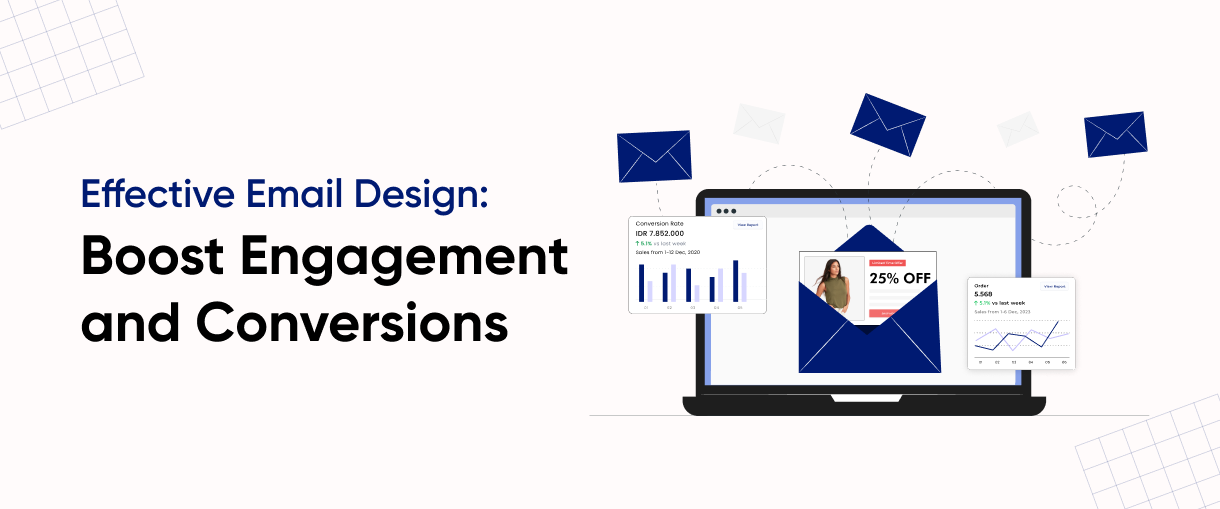Email marketing has become popular for businesses to engage with their audience and drive conversions. But, with the increasing volume of emails in our inboxes, businesses need to stand out. This is where effective email design comes in. A well-designed email catches the recipient’s attention and guides them towards taking a desired action, resulting in increased engagement and conversions.
In this write-up, we will explain the essential elements of effective email design and how it can significantly boost engagement and conversions for your business.
What is Email Design?
Email design is crafting attractive and impactful email messages to achieve marketing objectives. This involves choosing fonts, colors, images, and layouts to improve engagement and click-through rates. Good email design grabs people’s attention and effectively conveys messages. It is similar to decorating a home, where an interior designer considers various aspects such as size, color, layout, and furniture arrangement.
Importance of Effective Email Design
Email design plays a pivotal role in the success of your email marketing campaigns. A well-designed email grabs the reader’s attention and conveys your brand’s professionalism and credibility. When someone opens an aesthetically pleasing email, they are more likely to engage with its content and take the desired action.
One of the key advantages of effective email design is improved engagement rates. Emails that are attention-grabbing and easy to navigate encourage recipients to spend more time reading and interacting with your message. This can increase click-through rates, website traffic, and higher conversions.
Elements of a Well-Designed Email
The key elements of a well-designed email are:
- Compelling subject line: A strong subject line grabs attention and attracts recipients to open your email. It should be concise, personalized, and relevant to the content of the email.
- Clear and concise copy: The body of your email should be easy to read, concise, and scannable. You should break up your text into short paragraphs, bullet points, and subheadings to make it more easily digestible.
- Eye-catching visuals: Incorporating visually appealing elements such as images, infographics, and videos can grab the reader’s attention and enhance the overall design of your email.
- Strategic use of colors and fonts: Select colors and fonts that align with your brand to evoke desired emotions. Consistency in color schemes and font choices helps create a cohesive and professional look.
Best Practices for Email Design
To ensure your emails are attention-grabbing and effective, here are some best practices that you should follow:
Keep it simple
Avoid cluttering your email with excessive graphics, text, or multiple calls to action. A clean and simple design helps the recipient focus on the main message and call to action.
Use responsive design
Many emails are opened on mobile devices, so it’s important to design responsive emails that adapt to various screen sizes. Test your emails across various devices to ensure optimal display.
Optimize for quick loading
Emails that take too long to load will likely be ignored or deleted. Therefore, we suggest optimizing your email design by minimizing file sizes, using web-safe fonts, and optimizing images.
Include a clear call to action
Every email should have a clear and compelling call to action that tells the recipient what you want them to do next. Use actionable language and make the call to action prominent.
Personalization
Use the recipient’s name in the email to create a more personalized experience. Tailor the content to match their interests or previous interactions whenever possible.
Use a strong opening
Grab the reader’s attention with a compelling opening line or statement. This helps to create intrigue and encourages them to continue reading.
Proofread and test
Always proofread your emails for spelling and grammar errors before sending them. Additionally, test your emails across different email clients and devices to ensure they render correctly.
Segment your audience
Break your email list into smaller segments based on demographics, interests, or past interactions. This allows for more targeted and relevant content, which can increase engagement and conversion rates.
Include social sharing buttons
Add social sharing buttons to your emails so readers can easily share your content on social media. This way, more people can see your brand, and it can increase your visibility.
Monitor and analyze
Use analytics tools to observe your emails’ performance. You can see how many people are opening your emails and clicking on links and how many people are taking action based on your emails. This will help you determine what’s working and what’s not so you can improve.
By following these best practices, you can create well-designed, visually appealing, easy-to-read, and engaging emails for your audience.
Conclusion
Effective email design is crucial for boosting engagement and conversions in email marketing campaigns. By implementing the above-mentioned points, you can create visually appealing emails that capture your audience’s attention, drive clicks, and ultimately achieve your marketing goals. Remember to continuously test and optimize your email designs to ensure they resonate with your audience and deliver maximum results. So, apply these strategies today to take your email marketing to the next level.
We hope you enjoyed reading this blog. Stay tuned to our more blogs, too.

